| FRESNELS |
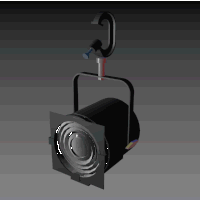 |
| PAR CANS |
 |
| ELLIPSOIDALS |
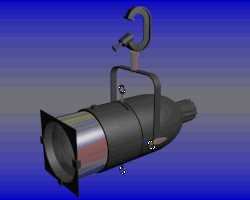 |
| FOLLOW
SPOTS |
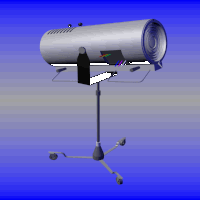 |
| SCOOPS |
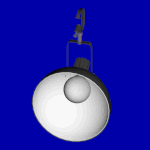 |
| STRIP
LIGHTS |
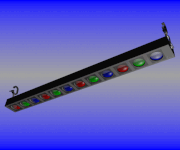 |
| BEAM PROJECTORS |
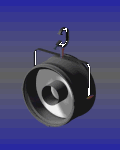 |
| CYC LIGHTS |
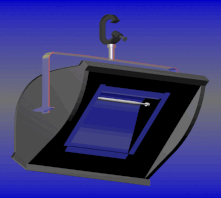 |
|
COMMON
LIGHTING INSTRUMENTS
 |
FRESNEL
A fresnel is a versatile, compact, light-weight,
and reasonably inexpensive lighting instrument. Excellent
for top light, backlight, and general washes.
|
|
|
|
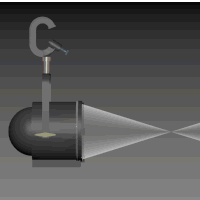 |
A
fresnel lens maintains the curvature and prescription
of a large convex lens in a much thinner version. The
curve is stepped back towards the flat side at regular
intervals. This is less expensive to produce and allows
more even heat distribution through the glass, protecting
the lens from expansion and contraction. The trade-off
is a fuzzier, softer field. |
| LENSES |
REFLECTOR |
FIELD |
HOUSING |
|
1 Fresnel lens
(as described above)
|
Spherically
shaped reflector. |
Soft
edge with extreme capacity for flooding and spotting
- this means it can be very wide, or very narrow. |
Housing style varies slightly. In many theatres, these
may be very old lights, as they last a long time. The
body shown here is very typical. |
| HOW
SIZE IS DETERMINED |
ACCESSORIES |
| Typical
sizes are 6", 8", and sometimes 12" fresnels.
This refers to the diameter of the lens.
|
You
cannot put gobos into this, and it has no shutters.
However, you can eliminate spill and shape the
light coming out using barn doors, or top hats. |
|
|
|
PAR
CAN
(parabolic aluminized reflector)
The
body of a par can is nothing but a metal shell for
the lamp, which includes lens and reflector within
it.
A parabolic
reflector produces a narrow shaft of light The glass
over the front of the lamp is divided into cells, which
spread the shaft sideways.
A
par lamp is a lot like a car headlight. By
putting different versions of the lamp into the instrument, the
beam can be wide, medium, narrow, or very narrow.
By
turning the lamp, the orientation of the field can be
set however desired. |
|
|
|
|
| LENSES |
REFLECTOR |
FIELD |
HOUSING |
The
lamp has the reflector and the lens built right into
it. The texture spreads the light sideways.
Different types of lamp include:
WFL=WIDE FLOOD MFL=MEDIUM FLOOD NSP=NARROW SPOT
|
PAR
Cans have a soft edge, but still create a clearly defined
area of light on stage. They are softer than
an ellipsoidal, but sharper than a fresnel. No
spot or flood adjustment is possible. In
order to change the spread of the light, you have to
put a different type of PAR lamp into the unit.
|
The
housing style shown here is typical. The
housing has no real effect on how this unit works. |
| HOW
SIZE IS DETERMINED |
ACCESSORIES |
|
Diameter
os the lamp, measured in one-eighths of an inch.
A PAR64 is 64/8" in diameter, or 8".
A PAR56 is 56/8", or 7".
|
Like
a fresnel, PAR Cans only use barn doors and top-hats.
No gobos, irises, or shutters can be installed. |
|
|
|
ELLIPSOIDAL
REFLECTOR SPOTLIGHT
(ERS)
|
|
|
Ellipsoidal
reflector spotlights do a lot, and can be very percise.
They can accept gobos and irises, and have built-in
shutters for shaping the field.
Ellipsoidals require a degree of maintenence and finesse;
they are less easy to use than other types of instrument
and are a bit more expensive.
|
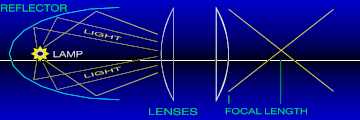
The distance between the two lenses is adjustable
by sliding the barrel, allowing good control over
the field. |
| LENSES |
REFLECTOR |
FIELD |
HOUSING |
| 2
PLANO-CONVEX LENSES; ONE IN MAIN BODY, ONE IN BARREL |
FACETED
ELLIPSOIDAL-SHAPED REFLECTOR. |
HARD
EDGED; MAY BE SOFTENED BY PUTTING BARREL OUT OF FOCUS |
HOUSING
STYLE VARIES. SHOWN HERE IS A TRADITIONAL AXIAL STYLE.
THE BOX-STYLE IS VERY TYPICAL OF NEWER UNITS. |
| HOW
SIZE IS DETERMINED |
ACCESSORIES |
WIDTH
OF LENS x FOCAL LENGTH, OR FIELD ANGLE
EXAMPLES: 6x9 ELLIPSOIDAL HAS A 6" DIA. LENS AND
A 9" FOCAL LENGTH. A 20 DEGREE ERS HAS THE SAME
FIELD ANGLE.
|
SHUTTERS
ALLOW SHAPING OF FIELD.
TOP-HATS MINIMIZE SPILL.
DONUTS SHARPEN FOCUS EVEN FURTHER.
GOBOS (OR PATTERNS) ALLOW EXTREME CONTROL OF FIELD SHAPE
AND QUALITY.
COLOR FRAME. |
|
|
|
FOLLOW
SPOT
The
most commonly know instrument. Follow spots are used
to highlight and follow a single performer onstage.
They require a certain amount of skill to operate
smoothly. Followspots typically have a variety of
colors that can be inserted with the flip of a lever,
as well as a gate, dowser, focus control, and an iris.
|
| LENSES |
REFLECTOR |
FIELD |
HOUSING |
| USUALLY
TWO STEP LENSES (DIFFERENT THAN A FRESNEL LENS;
STEPS ARE ON THE FLAT SIDE) |
VARIES;
SOME UNITS; SOME USE AN MR16 LAMP WHICH INCLUDES
REFLECTOR IN IT. |
SMOOTH
CONTROL OF RANGE FROM VERY SOFT TO VERY CRISP.
MEDIUM WIDTH TO NARROW .
|
HOUSING
STYLE VARIES SLIGHTLY. BODY SHOWN IS VERY TYPICAL. |
| HOW
SIZE IS DETERMINED |
ACCESSORIES |
| USUALLY
REFERRED TO BY MAKE AND MODEL ONLY. |
MULTIPLE
COLOR, GATE, IRIS, DOWSER, SPECIFICS OF EACH AND
MECHANICS VARIES. |
|
|
 |
SCOOP
(ELLIPSOIDAL REFLECTOR
FLOODLIGHT)
Scoops are lensless instruments, most commonly
used as worklights. They have an extremely wide field angle
ranging from 90 to 120 degrees. |
| LENSES |
REFLECTOR |
FIELD |
HOUSING |
| NONE. |
LARGE
ELLIPSOIDAL REFLECTOR WHICH DOUBLES AS HOUSING. |
WIDE
WITHOUT DEFINITION. SOME SCCOPS HAVE FLOOD AND SPOT SETTINGS.
CRISP FOCUS IS NEVER AN OPTION.
|
HOUSING
AND REFLECTOR ARE TYPICALLY ONE PIECE. |
| HOW
SIZE IS DETERMINED |
ACCESSORIES |
DIAMETER
OF REFLECTOR IN INCHES.
(18" SCOOP HAS AN 18" DIA. REFLECTOR) |
COLOR
FRAME ONLY.
|
|
STRIP
LIGHTS
are units with multiple lamps which, through color and control,
allow new colors to be mixed. Strip lights are good for
lighting cycloramas and are used effectively as top light.
On cycloramas, strip lights can be used alone or in conjunction
with cyc lights.
|
 |

Strip lights are wired so that a single electrical circuit
can control a single color. In a three-circuit strip it would
be quite normal to have red on the first circuit, blue on
the second, and green on the third. (In lighting, the primary
colors are red, blue, and green.) |
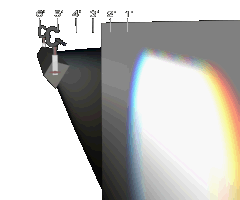 |
|
The optimum throw distance for strip lights
onto a cyclorama is about six feet . When
they are too close, the individual fields
become distinct, and color mixing is lost.
|
| LENSES |
REFLECTOR |
FIELD |
HOUSING |
NO
LENSES. SOME USE PAR LAMPS, SOME USE FLOOD LIGHTS, OTHERS
USE STANDARD LIGHT BULBS.
SOME USE LARGE COLORED GLASS DOMES, CALLED ROUNDELS,
INSTEAD OF TYPICAL COLOR. |
N/A |
SOFT
EDGED. OVERLAPPING FIELDS MIX TO PRODUCE DESIRED COLOR.
|
LONG
RECTANGULAR BOX, TYPICALLY SIX OR EIGHT FEET LONG. |
| HOW
SIZE IS DETERMINED |
ACCESSORIES |
| LENGTH
OF UNIT. USUALLY NUMBER OF CIRCUITS IS ALSO SPECIFIED. (8'
STRIP, THREE CIRCUIT) |
COLOR
FRAMES OR ROUNDELS. |
BEAM
PROJECTOR
Beam
projectors are inexpensive, lenless instruments good for creating
shafts of light in fog or haze and across cycloramas. They
can be used for general stage lighting, but their uneven field
usually leaves this function to other types of instrument. |
 |
|
| LENSES |
REFLECTOR |
FIELD |
HOUSING |
| NONE. |
PARABOLIC
REFLECTOR. |
UNEVEN,
LUMPY FIELD. NARROW.
MAY BE FLOODED OR SPOTTED. BEAM MAY VARY FROM 8 DEGREES TO
15 DEGREES. FIELD MAY RANGE FROM 8 DEGREES TO 25. |
CYLINDER.
VARIES BETWEEN MANUFACTUERS. |
| ACCESSORIES |
| COLOR
FRAME ONLY. |
| HOW
SIZE IS DETERMINED |
| USUALLY
NOT REFERRED TO. SOMETIMES DETERMINED BY DIAMETER OF OPENING
IN INCHES. |
 |
CYC
LIGHT
A
cyc light is an instrument specially designed for lighting
cycloramas. They serve one of the same functions as a strip
light. Their reflectlor, however, shapes the field in such
a way that the cyc is illuminated as brightly at the bottom
as it is at the top.
Cyc lights are frequently used in sets of three cells, with
a different color in each, allowing color mixing. Twelve single
cell units might be hung with red, blue, and green in them
alternating, with all of the reds controlled together, all
of the blues, etc. |
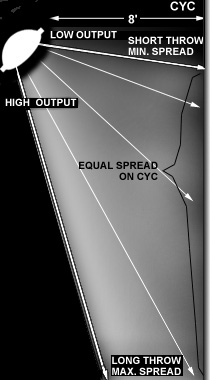 |
| LENSES |
REFLECTOR |
FIELD |
HOUSING |
| NONE. |
VERY
SPECIFIC SHAPE.
NOT A STANDARD GEOMETRIC SHAPE. |
BEAM
AND FIELD ARE RECTANGULAR, ABOUT 100 DEGREES EACH WAY.
EXTREMELY EVEN, SMOOTH FIELD. SEE DIAGRAM AT RIGHT. |
HOUSING
STYLE VARIES SLIGHTLY. BODY SHOWN IS VERY TYPICAL. |
| HOW
SIZE IS DETERMINED |
ACCESSORIES:
COLOR ONLY. |
| AVAILABLE
IN ONE CELL (SHOWN), TWO CELL, AND THREE CELL VERSIONS. |
|
|





